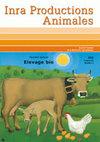La partition des nutriments entre fonctions physiologiques chez les vaches laitières dépend du génotype et de son expression dans le temps
IF 0.6
4区 农林科学
Q3 Agricultural and Biological Sciences
引用次数: 1
Abstract
It has become increasingly clear that understanding nutrient partitioning is central to a much broader range of issues than just being able to predict productive outputs. The extent to which nutrients are partitioned to other functions such as health and reproduction is clearly important, as are the efficiency consequences of nutrient partitioning. Further, there is mounting evidence that reliance on body reserves is increased and that robustness of dairy cows is reduced by selection for increased milk production. There is a need to incorporate in nutritional models the innate driving forces that alter nutrient partitioning according to physiological state i.e., the role of both the cow’s genotype (genetic make-up), and the expression of this genotype through time on nutrient partitioning. This paper summarizes work carried out to extend nutritional models to incorporate these trajectories, and how they affect the homeostatic capacity of the animal. There are now models that can predict the partition of nutrients throughout lactation for cows of differing milk production potentials. However, genotype and stage of lactation effects on homeostatic capacity has not yet been explicitly included in metabolic models that predict nutrient partition, although recent results suggest that this is achievable. These developments considerably extend the generality of nutrient partitioning models with respect to the type of animal and its physiological state. However, these models remain very largely focussed on predicting partition between productive outputs and body reserves and, for the most part, remain research models although substantial progress has been made toward developing models that can be applied in the field. The challenge of linking prediction of nutrient partitioning to its consequences on health, reproduction, and longevity, in the field. The challenge of linking prediction of nutrient partitioning to its consequences on health, reproduction, and longevity, although widely recognised, is only now beginning to be addressed. This is an important perspective for future work on nutrient partitioning.奶牛生理功能之间营养物质的分配取决于基因型及其随时间的表达
越来越清楚的是,了解营养分配对更广泛的问题至关重要,而不仅仅是能够预测生产产出。营养物质在多大程度上分配给健康和生殖等其他功能显然很重要,营养物质分配的效率也很重要。此外,越来越多的证据表明,对身体储备的依赖增加了,奶牛的健壮性因选择增加产奶量而降低。有必要在营养模型中纳入根据生理状态改变营养分配的先天驱动力,即奶牛的基因型(基因组成)和该基因型随时间对营养分配的表达的作用。本文总结了扩展营养模型以纳入这些轨迹的工作,以及它们如何影响动物的体内平衡能力。现在有一些模型可以预测不同产奶潜力的奶牛在整个哺乳期的营养分配。然而,基因型和泌乳阶段对体内平衡能力的影响尚未明确包括在预测营养分配的代谢模型中,尽管最近的研究结果表明这是可以实现的。这些发展极大地扩展了营养分配模型在动物类型及其生理状态方面的通用性。然而,这些模型仍然很大程度上集中于预测生产产出和身体储备之间的分配,并且在大多数情况下仍然是研究模型,尽管在开发可应用于该领域的模型方面取得了重大进展。将营养分配预测与其对健康、繁殖和寿命的影响联系起来的挑战。将营养分配的预测与其对健康、生殖和寿命的影响联系起来的挑战虽然已得到广泛承认,但现在才刚刚开始得到解决。这是今后营养分配研究的一个重要方向。
本文章由计算机程序翻译,如有差异,请以英文原文为准。
求助全文
约1分钟内获得全文
求助全文
来源期刊

Inra Productions Animales
Multiple-
CiteScore
1.30
自引率
33.30%
发文量
0
审稿时长
>36 weeks
期刊介绍:
This journal publishes scientific update reports, results of experiments and their possible applications, analyses on topical issues and presentation of research, information on scientific events and new publications.
INRA Productions Animales deals with all species of zootechnical interest (herbivores, monogastrics and fish), covering feed and nutrition, physiology, pathology, genetics, production techniques, product quality and production economics.
 求助内容:
求助内容: 应助结果提醒方式:
应助结果提醒方式:


